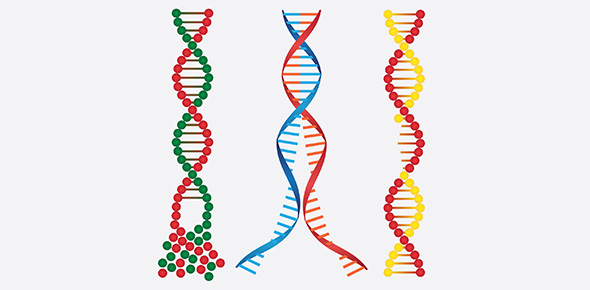Related Flashcards
Related Topics
Cards In This Set
| Front | Back |
|
1) Pea plants were particularly well suited for use in Mendel's breeding experiments for all of thefollowing reasons except thatA) peas show easily observed variations in a number of characters, such as pea shape and flowercolor.B) it is possible to control matings between different pea plants.C) it is possible to obtain large numbers of progeny from any given cross.D) peas have an unusually long generation time.E) many of the observable characters that vary in pea plants are controlled by single genes |
D) peas have an unusually long generation time.
|
|
2) What is the difference between a monohybrid cross and a dihybrid cross?A) A monohybrid cross involves a single parent, whereas a dihybrid cross involves two parents.B) A monohybrid cross produces a single progeny, whereas a dihybrid cross produces twoprogeny.C) A dihybrid cross involves organisms that are heterozygous for two characters and amonohybrid only one.D) A monohybrid cross is performed for one generation, whereas a dihybrid cross is performedfor two generations.E) A monohybrid cross results in a 9:3:3:1 ratio whereas a dihybrid cross gives a 3:1 ratio |
C) A dihybrid cross involves organisms that are heterozygous for two characters and amonohybrid only one.
|
|
3) A cross between homozygous purple-flowered and homozygous white-flowered pea plantsresults in offspring with purple flowers. This demonstratesA) the blending model of genetics.B) true-breeding.C) dominance.D) a dihybrid cross.E) the mistakes made by Mendel |
C) dominance.
|
|
4) The F1 offspring of Mendel's classic pea cross always looked like one of the two parentalvarieties becauseA) one phenotype was completely dominant over another.B) each allele affected phenotypic expression.C) the traits blended together during fertilization.D) no genes interacted to produce the parental phenotype.E) different genes interacted to produce the parental phenotype |
A) one phenotype was completely dominant over another.
|
|
5) What was the most significant conclusion that Gregor Mendel drew from his experiments withpea plants?A) There is considerable genetic variation in garden peas.B) Traits are inherited in discrete units, and are not the results of "blending."C) Recessive genes occur more frequently in the F1 than do dominant ones.D) Genes are composed of DNA.E) An organism that is homozygous for many recessive traits is at a disadvantage |
B) Traits are inherited in discrete units, and are not the results of "blending."
|
|
6) How many unique gametes could be produced through independent assortment by anindividual with the genotype AaBbCCDdEE?A) 4B) 8C) 16D) 32E) 64 |
D) 32
|
|
7) Two plants are crossed, resulting in offspring with a 3:1 ratio for a particular trait. ThissuggestsA) that the parents were true-breeding for contrasting traits.B) incomplete dominance.C) that a blending of traits has occurred.D) that the parents were both heterozygous.E) that each offspring has the same alleles |
D) that the parents were both heterozygous.
|
|
8) Two traits that appear in a 9:3:3:1 ratio in the F2 generation should have which of thefollowing properties?A) Each of the traits is controlled by multiple genes.B) The genes controlling the traits obey the law of independent assortment.C) Each of the genes controlling the traits has three alleles.D) Four genes are involved.E) Sixteen different phenotypes are possible |
B) The genes controlling the traits obey the law of independent assortment.
|
|
9) A sexually reproducing animal has two unlinked genes, one for head shape (H) and one fortail length (T). Its genotype is HhTt. Which of the following genotypes is possible in a gametefrom this organism?16A) HTB) HhC) HhTtD) TE) tt |
A) HT
|
|
10) It was important that Mendel examined not just the F1 generation in his breedingexperiments, but the F2 generation as well, becauseA) he obtained very few F1 progeny, making statistical analysis difficult.B) parental traits that were not observed in the F1 reappeared in the F2C) analysis of the F1 progeny would have allowed him to discover the law of segregation, butnot the law of independent assortment.D) the dominant phenotypes were visible in the F2 generation, but not in the F1E) many of the F1 progeny died |
B) parental traits that were not observed in the F1 reappeared in the F2
|
|
11) When crossing an organism that is homozygous recessive for a single trait with aheterozygote, what is the chance of producing an offspring with the homozygous recessivephenotype?A) 0%B) 25%C) 50%D) 75%E) 100% |
C) 50%
|
|
12) Which of the boxes marked 1-4 correspond to plants with dark leaves?A) 1 onlyB) 1 and 2C) 2 and 3D) 4 onlyE) 1, 2, and 3 |
E) 1, 2, and 3
|
|
13) Which of the boxes correspond to plants with a heterozygous genotype?A) 1B) 1 and 2C) 1, 2, and 3D) 2 and 3E) 2, 3, and 4 |
D) 2 and 3
|
|
14) Which of the plants will be true-breeding?A) 1 and 4B) 2 and 3C) 1—4D) 1 onlyE) None |
A) 1 and 4
|
|
15) Mendel accounted for the observation that traits which had disappeared in the F1 generationreappeared in the F2 generation by proposing thatA) new mutations were frequently generated in the F2 progeny, "reinventing" traits that had beenlost in the F1B) the mechanism controlling the appearance of traits was different between the F1 and the F2plants.C) traits can be dominant or recessive, and the recessive traits were obscured by the dominantones in the F1D) the traits were lost in the F1 due to blending of the parental traits.E) members of the F1 generation had only one allele for each character, but members of the F2had two alleles for each character |
C) traits can be dominant or recessive, and the recessive traits were obscured by the dominantones in the F1
|






